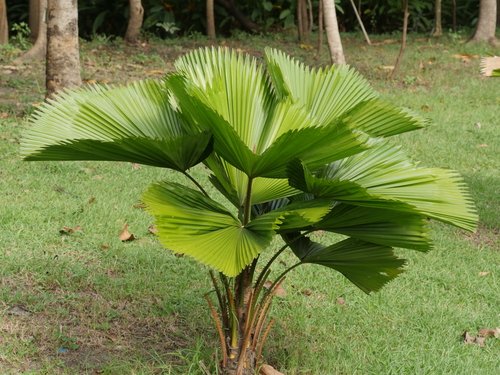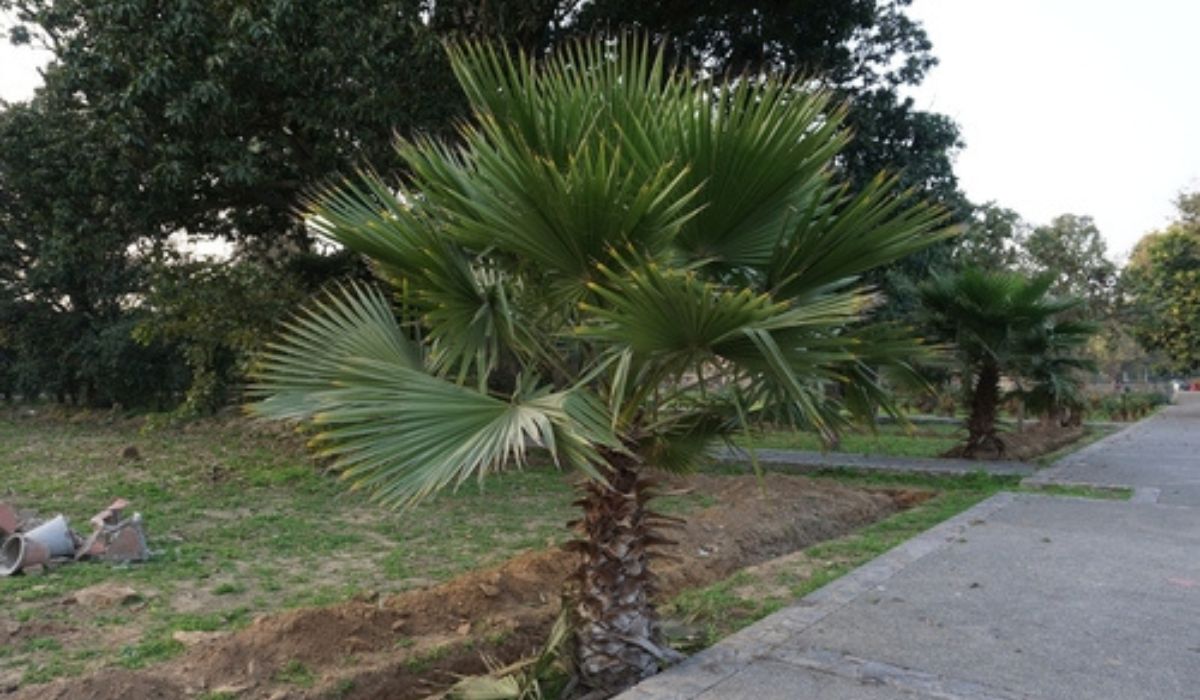Fan palm trees or Chamaerops are among the most popular indoor tropical plants and can only thrive in environments with a lot of natural light and plenty of room to move around. There are some people who do not have the correct growth circumstances to be able to cultivate tropical flavours in their gardens.
Gardeners can still plant this tree. Continue reading for helpful hints on how to cultivate fan palms.
Fan palm: Quick facts
| Common Name | Fan palm, European fan palm, Mediterranean fan palm, Mediterranean dwarf palm |
|---|---|
| Botanical Name | Chamaerops humilis |
| Kingdom | Plantae |
| Clade | Tracheophytes |
| Family | Arecaceae |
| Height | Up to 20 metres |
| Native | Mediterranean |
| Benefits | Ornamental plant |
Known about Dianthus Barbatus
Fan palm: Features
- The common name for these plants comes from the fact that each one has 9 to 12 enormous leaves that are segmented, pleated, and almost circular in shape. These leaves seem like a large pinwheel or fan.
- The underside of the leaflets has a greyish colouration, while the tops are brilliant green.
- Along the stem of the leaf, which may reach a length of two metres, there are spines.
- The species is also known by its other popular name, the Hessian hair fan palm, which refers to the fibrous mesh that hangs from the leaf sheath.
- The fan palm was an essential plant for the Aboriginal people who lived in the north of Queensland.
- It was used for thatching, as well as for giving shelter from the severe rains, as well as for wrapping food and other applications.

Know about: Dwarf Umbrella Tree
Fan palm: Types
- The Chinese fan palm (Livistona chinensis) is a favourite outdoor plant in Florida, and it may also thrive indoors in a brightly lit area. The leaves of this slow-growing palm can get as long as 2 metres (6 feet), while the tree itself has a single, solitary stem.
- An elegant multi-stemmed indoor palm, the European fan palm (Chamaerops humilis) is a great choice. Each frond has a stem that is 4 feet (1 metre) in height and is topped with a fan-shaped frond. The full-grown size of these plants’ greyish-green leaves is roughly 2 feet (61 cm).
Fan palm: How to grow?
- A fan palm plant does well in clay, loam, and sand, as long as it has ample sunlight and any soil that is rich, well-drained, and well-drained.
- Palms need to be spaced evenly, whether they are planted directly in soil or in containers. Allow its fronds to spread properly by keeping them at least one and a half metres away from any walls.
- Taking care of your trees is as simple as removing dead leaves from below the crown once a year for outdoor trees.
- In any medium, whether acidic, alkaline, or neutral, it grows well. You may need to provide it with some shelter until it reaches maturity due to its sensitivity to bright sunlight when it is young.
- During the growing season, from early spring to fall, you should fertilise it twice or three times a year to encourage its growth. A granular palm fertiliser is the best, and most effective, and organic mulch will also help it grow.
Fan palm: Maintenance tips
- The plant soil should be allowed to dry up somewhat more in the winter than it should throughout the summer.
- The humidity may be maintained at a high level with the aid of a daily mist of water.
- If the tips of the fronds become brown, this indicates that the humidity is too low.
- Maintaining the vitality of fan palm plants requires only a minimal amount of fertiliser to be applied from late winter through early fall.
- The potting soil that is used for palm plants should have good drainage, and the bottom of any container that is used for the plant should have a sufficient number of drainage holes.
- During the growth season, the soil should always be wet; nevertheless, it is also important to prevent the soil from being too saturated since this can cause root rot.
- As long as the temperature in the room is kept between 55 and 60 degrees Fahrenheit, it is not difficult to cultivate fan palms (13-16 degrees Celsius).
- Keep palm trees away from heating or cooling vents as well as ceiling fans, as these might create temperature changes.
- The potting soil that is used for palm plants should have good drainage, and the bottom of any container that is used for the plant should have a sufficient number of drainage holes.
- Regardless of pH, it grows well in acidic, alkaline, or neutral environments. Young plants can be a bit sensitive to bright sunlight, so you might want to give them some shelter until they become fully grown
- During the growing season, from early spring until fall, you should fertilise it two or three times to encourage its growth.
- Pruning the Chinese fan palm is a very simple procedure since you simply remove the dead leaves from the crown’s base. The Chinese fan palm has an upright growing habit; however, it will need occasional pruning to build a sturdy structure.
- For its fronds to spread properly, keep it at least one and a half metres away from any wall. It should be grown in containers with a minimum distance of one metre between each container. Plants like this grow very slowly, so you won’t need to repot them often.
Fan palm: Uses
- It is commonly used in lipstick, soaps and detergents, as well as ice cream. Although palm oil is a small ingredient in the American diet, it consumes more than half of all packaged products.
- With its beauty and cold hardiness, the fan palm is primarily grown for its ornamental value.
- Its wood has, however, been used for centuries in China to make umbrella handles and walking sticks.
- Due to their astringent nature, phenolic compounds in seeds and fruits also have antibacterial properties.
Beautifying your home with Fan Palms


Fan Palms: Ideal choice for indoor greenery


Enhance your space with tall fan palms


FAQs
What is the native range of fan palms?
Fan palms are only found in the wet tropics.
What is the maximum height of a fan palm?
They grow around 70 to 200 feet tall.
Housing News Desk is the news desk of leading online real estate portal, Housing.com. Housing News Desk focuses on a variety of topics such as real estate laws, taxes, current news, property trends, home loans, rentals, décor, green homes, home improvement, etc. The main objective of the news desk, is to cover the real estate sector from the perspective of providing information that is useful to the end-user.
Facebook: https://www.facebook.com/housing.com/
Twitter: https://twitter.com/Housing
Email: [email protected]










